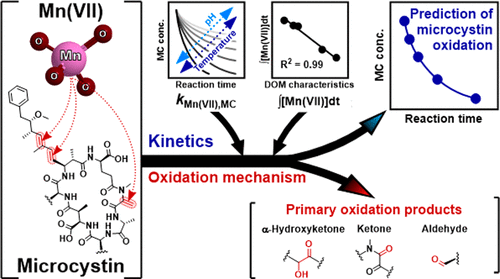Publication
Advanced Redox Technology Lab
Publication
Advanced Redox Technology Lab
Journal papers
Oxidative degradation of six representative microcystins (MCs) (MC-RR, -LR, -YR, -LF, -LW, and -LA) by potassium permanganate (KMnO4; Mn(VII)) was investigated, focusing on the temperature- and pH-dependent reaction kinetics, the effect of dissolved organic matter (DOM), and the oxidation mechanisms. Second-order rate constants for the reactions of the six MCs with Mn(VII) (kMn(VII),MC) were determined to be 160.4–520.1 M–1 s–1 (MC-RR > -LR ≈ -YR > -LF ≈ -LW > -LA) at pH 7.2 and 21 °C. The kMn(VII),MC values exhibited activation energies ranging from 15.1 to 22.4 kJ mol–1. With increasing pH from 2 to 11, the kMn(VII),MC values decreased until pH 5, and plateaued over the pH range of 5–11, except for that of MC-YR (which increased at pH > 8). Species-specific second-order rate constants were calculated using predicted pKa values of MCs. The oxidation of MCs in natural waters was accurately predicted by the kinetic model using kMn(VII),MC and Mn(VII) exposure (∫[Mn(VII)]dt) values. Among different characteristics of DOM in natural waters, UV254, SUVA254, and the abundance of humic-like substances characterized by fluorescence spectroscopy exhibited good correlation with ∫[Mn(VII)]dt. A thorough product study of MC-LR oxidation by Mn(VII) was performed using liquid chromatography–mass spectrometry.
